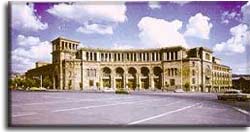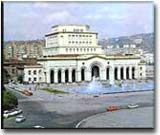|
|
Also
situated on Republic Square are the Armenian History Museum and the Art
Gallery of Armenia. Here, one finds informative and interesting models
and artifacts of ancient Urartu and Armenia. In the Art Gallery one finds
a worthy section on Armenian art from the seventh century AD. Amongst
the many other museums in the capital city, the two most interesting house
museums are those of landscape artist Martiros Saryan (1880-1972) and
twentieth century composer Aram Khatchaturyan.
As you explore the many interesting sights in Yerevan, you will learn about the culture and history of one of the world's oldest nations. |
|
C
u l t u r a l h e r i t a g e
|
|
To gain further insights into Armenian cultural achievements you must visit her museums, theaters and concert halls. Theater in Armenia has a tradition dating back more than 2,000 years. You can attend a wide choice of performances ranging from concerts to puppet theater and jazz music. At the top of Mesrop Mashtots Avenue, the main artery of the capital city Yerevan, you will find the Matenadaran - the Institute of Ancient Manuscripts. Matenadaran boasts the world's largest collection of ancient manuscripts (over 16,000). The collection includes many valuable works of foreign philosophers, some of which have survived only in their Armenian translation. Among these are works by Aristotle, Eusebius of Caesarea and many others. |
 |
|
|
Art aficionados can visit the National Art Gallery displaying its rich collections of works by European and Russian artists. This impressive building located in the Republic Square is also home to the largest national collection of paintings by famous Armenian artists such as Aivazovski and Sarian. The spirit of creativity is fostered and promoted in Armenians from the young age.Hence, the Children's Art Gallery, which was the first permanent exhibition of its sort in the world. It is conveniently located at 13 Abovian street, one of the better preserved streets of old Yerevan. |
| The homes of many famous Armenian writes, poets, and artists are now open to tourists. Enjoy a leisurely stroll around Yerevan and take in its unique architectural vistas. Yerevan's architectural character stands out in that of the most of the buildings are constructed of various colors of tufa and basalt, both of them products of volcanic nature. This makes Yerevan one of the few cities with no painted buildings. The city is enshrined with many internationally acclaimed statues by famous sculptors, such Yervand Kochar, Levon Tokmadjian. Most of the statues depict Armenian national heroes or glorify events of national importance. It is advisable to check out the following: | 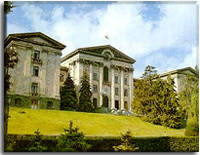 |
||||||||||||||
|
|||||||||||||||
|
A t t r a c t i o n s a n d r e s o r t s i n t h e v i c i n i t y o f Y e r e v a n |
|
| Armenia is often referred to as a museum in the open air. There are about 40,000 historical monuments spread across Armenia. In 301 AD, Armenians were the first nation to make Christianity their state religion. As a result, much of Armenian cultural heritage is shaped by symbols and values associated with the Christian faith. Many of the 40,000 surviving ancient monuments in Armenia are Christian churches and monasteries, most of which were built over demolished pagan temples. Hence, only one pagan temple remains in Armenia, Garni. |
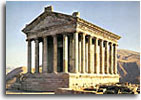 |
|
|
In
building their churches, Armenians made a significant contribution to
the world's architectural tradition. They developed the concept of laying
out the floor plan of a church in the shape of a cross. This early Christian
basilica style was later incorporated into the Gothic architecture of
European cathedrals.
The most characteristically Armenian medium for sculpture was the khach'k'ar, from the word for cross (khach') and stone (k'ar). |
| These free standing, rectangular shaped cross-stones are found everywhere in Armenia; there are thousands of them in all sizes from forty centimeters to two meters high and more.Without exception the central motif is a cross, elaborately and elegantly carved. Smaller khach'k'ars are often found inserted into the walls of churches, for example Hovhannavank', and placed at church doorways. Like the stelae of the earlier centuries, which perhaps they replaced starting in ninth century, they were used both as gravestones and as commemorative markers.Khach'k'ars were often inscribed with a date, the name of the person remembered, and at times the name of the artist. The earliest examples from the ninth, tenth and eleventh centuries are usually sober in their design, though often elegant in execution. The cross is always framed by an elaborately carved band and sometimes surmounted by an arch. Small carved circles are placed at the corners of the concave ends of each of the four arms of the cross; in later centuries these circles are transformed into trilobed foliage. |
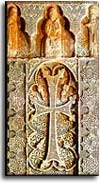 |
 |
Etchmiadzin is the religious center of Armenia. It is the Holy Seat of the Armenian Apostolic Church. Its Cathedral was built in 301 AD on a site of a former pagan temple.
|
|
O
t h e r s i g n i f i c a n t a t t r a c t
i o n s i n c l u d e :
|
||||||||||||||
|
|
|
|||||||||||
|
|
|||||||||||
|
|
|||||||||||
© 2001 wushu2001.am
All Graphics and layouts property of the webmaster.
Questions, Comments & Suggestions about the site? Email the webmaster

